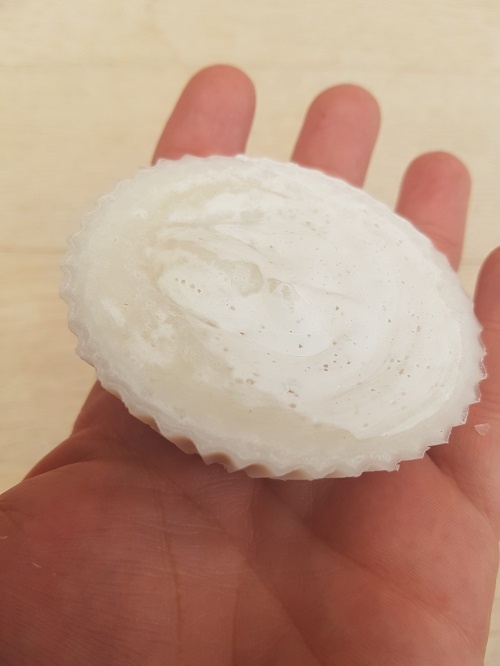This soap recipe is specifically composed for those who don’t like to use palm oil in their household.
To get a longer-lasting bar, we added some vinegar – You can use apple cider vinegar or any other you like, as long as it is 5% acetic acid. Read more about how and why we add vinegar to recipes here (link). In the link, you will also find a description of how to recalculate your recipe if your vinegar is not 5% acetic acid.
Shea Butter benefits
Shea Butter is one of our most beloved fats for soap recipes. It conditions, tone, and soothes the skin and is one of the best kinds of butter for skincare. Shea butter contains high concentrations of fatty acids, vitamins and has anti-inflammatory and healing properties.
Do you know you can use shea butter alone as a moisturizer and face cream? You don’t have to buy expensive skincare products – Just use Shea Butter.
Sometimes shea butter is called shea nut butter, but it is the same product.
The difference between Refined and Unrefined Shea Butter
Unrefined means shea butter extracted and prepared without the use of chemicals or preservatives. Refined shea butter has been chemically altered to remove the natural scent and bleached white. Refined Shea Butter retains only a small portion of its natural healing properties. Unrefined shea is cheaper, but be aware of its expiry date.
Unrefined shea butter will give your soap a little of a natural scent and color that some people find unpleasing. That is why this recipe is fragranced. We never recommend using refined shea butter.
The problem with Palm Oil
Palm oil has been and continues to be a major driver of deforestation of some of the world’s most biodiverse forests, destroying the habitat of already endangered species like the Orangutan, pygmy elephant and Sumatran rhino. This forest loss coupled with conversion of carbon rich peat soils are throwing out millions of tonnes of greenhouse gases into the atmosphere and contributing to climate change. There also remains some exploitation of workers and child labour. These are serious issues that the whole palm oil sector needs to step up to address because it doesn’t have to be this way.
WWF
Here on Soap-Recipes.com, we only recommend using organic palm oil, but we also have many recipes free from palm oil.
Recipe percentages, lye, and superfat
This information is for advanced soapers. Go to recipe if you are new to soap making.
- 30% Olive Oil
- 30% Coconut Oil
- 18% Rapeseed Oil, unrefined Canola
- 15% Shea Butter
- 7% Castor Oil
- 27.178% Lye Concentration
- 38% Water percent of oil weight
- 30% of the water substituted for Apple Cider Vinegar
- 3% Superfat
- 22 oz Total oil weight (624) g
- 0.5 Fragrance Ratio
Soap Quality
(This is before adding vinegar)
| Soap Quality | Range | This Recipe |
| Hardness | 29 – 54 | 36 |
| Cleansing | 12 – 22 | 20 |
| Conditioning | 44 – 69 | 60 |
| Bubbly | 14 – 46 | 26 |
| Creamy | 16 – 48 | 22 |
| Iodine | 41 – 70 | 62 |
| INS | 136 – 165 | 145 |
Recipe for Shea Butter soap without Palm Oil
Shea Butter Soap
Equipment
- 2 plastic, glass, or steel bowls
- Wooden or plastic spoon
- Stick blender
- Microwave oven
- Thermometer
- Silicone molds
- pH meter or test strips
- Kitchen scale
- Safety gear
Materials
- 6.60 oz Olive Oil 187 grams
- 6.60 oz Coconut Oil 187 grams
- 3.96 oz Rapeseed Oil, unrefined canola 112 grams
- 3.30 oz Shea Butter 94 grams
- 1.54 oz Castor OIl 44 grams
- 5.85 oz Water 166 grams
- 2.51 os Apple Cider Vinegar 71 grams
- 3.21 oz NaOH 91 grams
- 0.69 oz Essential OIl or fragrance 20 grams
Instructions
- Let us soap safely, read the guide before starting.
- Add Apple cider vinegar to water and use the cold process for soapmaking
Soap Fatty Acid Profile
| Lauric | 14 |
| Myristic | 6 |
| Palmitic | 8 |
| Stearic | 8 |
| Ricinoleic | 6 |
| Oleic | 34 |
| Linoleic | 8 |
| Linolenic | 2 |
Other Shea Butter Recipes
Most of our recipes with shea butter are also free from palm oil. You can browse them here (link)





